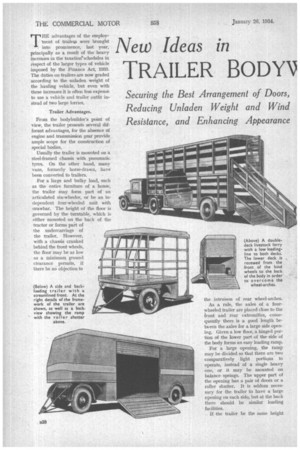New Ideas in
Page 38

Page 39

If you've noticed an error in this article please click here to report it so we can fix it.
TRAILER BODYV
)RK DESI6N
T'ment of traileys were brought HE advantages of the employinto prominence, last year, principally as a result of the heavy increases in the taxationilschedules in respect of the larger types of vehicle imposed by the Finance Act, 1933. The duties on trailers are now graded according to the unladen weight of the hauling vehicle, but even with these increases it is often less expense to use a vehicle and trailer outfit instead of two large lorries.
Trailer Advantages.
From the bodybuilder's point of view, the trailer presents several different advantages, for the absence of engine and transmission gear provide ample scope for the construction of special bodies.
Usually the trailer is mounted on a steel-framed chassis with pneumatic tyres. On the other hand, many vans, formerly horse-drawn, have been converted to :trailers.
For a large and bulky load, such as the entire furniture of a house, the trailer may form part of an articulated six-wheeler, or be an independent four-wheeled unit with drawbar. The height of the floor is governed by the. turntable, which is either mounted on the back of the tractor or forms part of the undercarriage of the trailer. However, with a chassis cranked behind the front wheels, the floor may be as low as a minimum ground clearance permits, if there be no objection to
the inhrukon of rear wheel-arches.
As a rule, the axles of a fourwheeled trailer are placed close to the front and rear extremities, consequently there is a good length betIA een the axles for a large side opening. Given a low floor, a hinged portion of the lower part of the side of the body forms an easy loading ramp.
For a large opening, the ramp may be divided so that there are two comparatively light portions to operate, instead of a single heavy one, or it may be mounted on balance springs. The upper part of the opening has a pair of doors or a roller shutter. It is seldom necessary for the trailer to have a large opening on each side, but at the back there should be similar loading facilities.
If the trailer be the same height
and width as the tractor, it may be considered that streamlining of the body is superfluous, especially as it tends to reduce loading capacity. Many trailers, however, are considerably higher than the tractor. In these instances, if should be an advantage to reduce wind resistance by sloping the front of the trailer above the level of the tractor roof, in addition to rounding the front corners and roof.
The reduction of the weight of trailers has recently received much attention. The type best suited for weight reduction is the box body with flat sides and ends, and without wheel-arches. All-metal or composite forms of construction may be utilized and the flat sides cross-braced.
A low tare weight is rnpre likely to be achieved if there be no side openings and loading is confined to the rear, or the front and rear. It is considered that an independent trailer, if it be not designed for side, as well as end, loading, should have openings at each end when the body is more than 12 ft. long.
Large double-deck livestock lorries are sometimes built as articulated outfits. As a rule, the height of the lower deck is determined by the least dimension required to obviate wheel-arches. As a low-loading height for both decks
is desirable, a compromise could be effected by building the lower deck narrower from the front of the hind wheels to the back of the body.
The lower deck above the turntable would be higher than the rear portion, with access by means of a removable ramp. This part of the lower deck would be loaded first and unloaded after the other part had been cleared, unless it had a separate exit. The upper deck would be level and the same width throughout. In this way a certain amount of space on the lower deck would be sacrificed for the advantage of a general lower loading line for both compartments. • Apart from • the many variations of the large trailer with two or more wheels, there are many interesting smaller patterns, chiefly: twowheelers, which serve a wide range of purposes. If such be drawn by a car taxed according to its horse power rating, no further tax has to be paid, unless it be used to carry for "hire or reward."
A trailer of this type may be used by the travelling salesman for carrying samples. A box body suitable for a load of 10-12 cwt, is from 7 ft. to 9 ft. long, and, if built between the wheels, is about 3 ft. 6 ins. wide.
Equipment for Samples.
The body may have doors at each end, or the whole of each side opens, the only obstruction being a central pillar and the upper part of the wheel and wing. According to the kind of sample carried, so the equipment of the trailer may be varied.
If the width of the two-wheeled trailer be greater than the track, it will be convenient to divide the side of the body into three compartments. The end ones extend for the full height of the body,. and the centre one occupies only the space above the wheel-arch.
Each division is protected by a roller shutter, and may consist of a showcase, or a division with drawers and locker. Each side of the body may be of similar design, although the arrangement may be varied by having one or more end doors which give access to transverse shelving and "lockers. When the goods are displayed for inspection, the trailer is equipped with hinged legs.




















































































